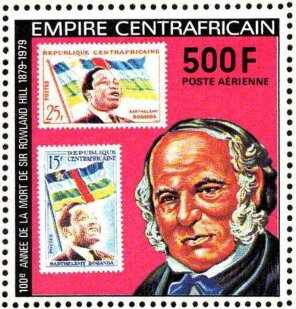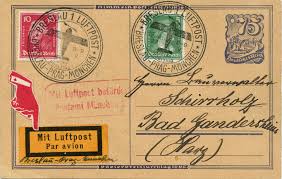Stamp: Sir Rowland Hill and President Barthélémy Boganda stamp (Central African Republic 1978)
Sir Rowland Hill and President Barthélémy Boganda stamp (Central African Republic 1978)
09 December (Central African Republic ) within release Memorial centenary of Sir Rowland Hill goes into circulation Stamp Sir Rowland Hill and President Barthélémy Boganda stamp face value 500 Central African CFA franc
| Stamp Sir Rowland Hill and President Barthélémy Boganda stamp in catalogues | |
|---|---|
| Michel: | Mi: CF 597 |
Stamp is square format.
Stamp from souvenir sheetAlso in the issue Memorial centenary of Sir Rowland Hill:
- Stamp - Sir Rowland Hill and Great Britain number 2 stamp face value 1,500;
- Stamp - Sir Rowland Hill and President Barthélémy Boganda stamp face value 500;
Stamp Sir Rowland Hill and President Barthélémy Boganda stamp it reflects the thematic directions:
An anniversary is the date on which an event took place or an institution was founded in a previous year, and may also refer to the commemoration or celebration of that event. For example, the first event is the initial occurrence or, if planned, the inaugural of the event. One year later would be the first anniversary of that event. The word was first used for Catholic feasts to commemorate saints. Most countries celebrate national anniversaries, typically called national days. These could be the date of independence of the nation or the adoption of a new constitution or form of government. The important dates in a sitting monarch's reign may also be commemorated, an event often referred to as a "Jubilee".
A head of state (or chief of state) is the public persona that officially represents the national unity and legitimacy of a sovereign state. In some countries, the head of state is a ceremonial figurehead with limited or no executive power, while in others, the head of state is also the head of government. In countries with parliamentary governments, the head of state is typically a ceremonial figurehead that does not actually guide day-to-day government activities and may not be empowered to exercise any kind of secular political authority (e.g., Queen Elizabeth II as Head of the Commonwealth). In countries where the head of state is also the head of government, the president serves as both a public figurehead and the actual highest ranking political leader who oversees the executive branch (e.g., the President of the United States).
Postal history is the study of postal systems and how they operate and, or, the study of the use of postage stamps and covers and associated postal artifacts illustrating historical episodes in the development of postal systems. The term is attributed to Robson Lowe, a professional philatelist, stamp dealer and stamp auctioneer, who made the first organised study of the subject in the 1930s and described philatelists as "students of science", but postal historians as "students of humanity". More precisely, philatelists describe postal history as the study of rates, routes, markings, and means (of transport).
A postmaster is the head of an individual post office, responsible for all postal activities in a specific post office. When a postmaster is responsible for an entire mail distribution organization (usually sponsored by a national government), the title of Postmaster General is commonly used. Responsibilities of a postmaster typically include management of a centralized mail distribution facility, establishment of letter carrier routes, supervision of letter carriers and clerks, and enforcement of the organization's rules and procedures. The postmaster is the representative of the Postmaster General in that post office.




